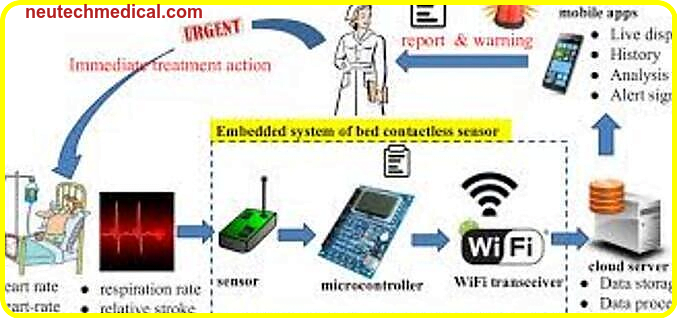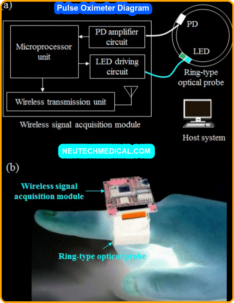
Pulse Oximeter
Pulse oximeters (SpO2) are non-invasive medical devices that continuously measure the heart rate but the oxygen saturation rate of hemoglobin in the capillaries.
other definition -A photoelectric device that measures oxygen saturation of the blood by recording the amount of light transmitted or reflected by deoxygenated versus oxygenated hemoglobin.
Uses
A pulse oximeter whose sensor is attaches to a finger the oxygenation of blood flowing through the finger can determine.

How the device connected to the patient-
Sensor position:- It can place at the level of the fingers, toes, the nose, or the soles of the feet in children.
The majority of the time is present in the form of a finger clamp or a finger.
Working principle
The oximeters are equipment with a sensor compose of an emitting part and a receiving part. The sensor will emit two types of lights-
One red light and the other one infrared light absorption characteristic of oxygenated and deoxygenated hemoglobin.
In contact with the pulsatile flow of blood, each of these two lumens will be more or less absorbed, depending on the type of hemoglobin encountered.
Article About:- Health & fitness
Article About:- Medical Technology
Article About:- Sports
Wavelength both light
Red light is in the 600-750 nm wavelength light band. Infrared light is in the 850- 1000 nm wavelength light band.
Deoxygenated (or reduced) hemoglobin absorbs more red light. Oxygenated hemoglobin absorbs more infrared light.
A normal level of oxygen is usually 95% or higher. Some people with chronic lung disease or sleep apnea can have normal levels of around 90%. The pulse oximeter measures the pulse rate, blood oxygen saturation, the perfusion index. In some of the machines, the respiratory rate (RR).
What are 2 readings and 3 readings on a pulse oximeter
This is a reading that indicates what percentage of your blood is saturated, known as the SpO2 level. This test has a 2 percent error window. This means the reading may be 2 percent higher or lower than your actual blood oxygen level. This test may be a little less accurate, but it is much easier to perform.
whereas The pulse oximeter also measures pulse rate, blood oxygen saturation (SpO2), perfusion index (PI), and in some machines, respiratory rate (RR). The pulse rate can normally show a wide variation of 60–110 beats per minute (bpm).
How does a oximeter detect oxygen levels
A pulse oximeter is a pocket-friendly device that usually slides on your fingers or a clip on your ear lobe and uses infrared light refraction to measure how well oxygen is working for your red blood cells. The pulse oximeter uses a cold light source that shines light through the fingers, causing the tip to appear red. By analyzing light from a light source passing through the finger, the instrument is able to determine the percentage of oxygen in a red blood cell.
An ideal oxygen level is between 96% and 98% and an ideal heart rate is between 50 and 90 beats per minute (bpm). Some people with lung disease may have low oxygen levels, even if they are feeling well. We assume that right middle finger and right thumb have the most accurate value that reflects the arterial oxygen saturation.
The normal level of oxygen is usually 96% or more. Normal levels may be around 90% in some people with chronic lung disease or sleep apnea. The “SpO2” reading on a pulse oximeter refers to the percentage of oxygen in one’s blood. If the SpO2 reading in your home is less than 94%, call your healthcare provider.
